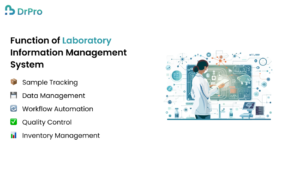Quick Summary
LIMS System software or solutions are requirements in the current information-age laboratories since they support data management, compliance, and efficient laboratory procedures. This article describes the primary purpose of This software. It outlines the five primary improvements that optimize the performance of the laboratory and support data credibility, adherence to regulatory standards, asset utilization, and conjunction with additional related systems.
Introduction
Over time, the roles that laboratories play in industries are ever-becoming larger and so are the expectations for higher accuracy and efficiency in what laboratories do, which in the process implies getting better in the kind of systems that are put in place to support them and guarantee compliance with the regulations that reign in the market. LIMS System has therefore proved to be very crucial in meeting these objectives. A Laboratory management system is specifically built for samples, data, and workflow since most laboratories are in a position to deal with very complex issues.
It outlines how in today’s ever-growing significance, the core importance overshadows other seemingly basic responsibilities of the LIMS System in handling data. It serves as a tool for the Laboratory to adapt, enhance, and control their activities, minimize mistakes, and boost performance. This article will explain the general and essential purposes of LIMS System and describe the list of the five real advantages a laboratory can get from employing this system.
Function of Laboratory Information Management System

A Laboratory Information Management System encompasses several essential functions that collectively enhance laboratory operations:
Sample Tracking:
The laboratory management system assigns numbers to samples received in laboratories and enables tracking of samples through the entire life cycle before reporting the results of the analysis. This helps in making sure that samples are well managed and that there cannot be a mix–up on the samples.
Data Management:
Centralization of data is made in LIMS System, thus information can be handled in laboratories. Since its data is in the past, it makes it easier to facilitate decision-making and analysis.
Workflow Automation:
As a result of automating some of the indispensable activities including data entry and report generation, the LIMS System relieves the workforce in the respective laboratory. This automation is effective in reducing workload and minimizing the chance of errors.
Regulatory Compliance:
LIMS also supports compliance with industry regulations by recording, storing, and archiving the records, audit trails, and documentation associated with laboratory inspections and audits.
Reporting and Analytics:
LIMS contains features that allow users to build reports and analyze data to enable laboratories to make meaningful conclusions from the information collected.
Inventory Management:
The physical management of supplies, reagents, and laboratory equipment is well managed by LIMS System. This function helps to confirm that stock levels are enough in that they check for expired product dates.
Quality Control:
Quality control about its function in LIMS System is the procedure for assuring and maintaining the accuracy and precision of tests conducted by the laboratory.
User Access Control:
It’s opens the possibility for laboratories to provide different types of user access so that only specific personnel can access specific information. This function has the effect of improving data protection and privacy.
List of 5 Benefits That Come with LIMS Systems

1. Improved Efficiency
Another advantage of integrating a LIMS System is the enhancement of laboratory productivity. Several procedures are automated enabling laboratories to execute tasks efficiently and effectively. The ILAC global survey showed that laboratories that adopted and used Software mentioned that it helped to cut down the time taken in processing and delivering test results by up to 30%.
Here, the efficiency improvements discussed are in main features related to the decrease in manual work. For instance, it provides a capability that enables it to create and present the test outcomes and the report on its own, reducing time on entering data and performing clerical tasks. Also, this software enables proper planning of the resources such that the staffing of the laboratory and availability of the instruments are adequately done. Comparatively, the turnover is faster and this benefits clients and stakeholders because the laboratories are capable of offering accurate results.
2. Enhanced Data Integrity
The purity of results is a key factor in laboratories and assuring that the results collected are correct is of paramount importance. LIMS automatically decreases some sources of error that are inherent in the manual collection of data. According to a report on the FDA, centers that employ DrPro‘s LIMS System notice a reduction of error in data entry by 40%.
it can achieve this through features of automating data acquisition and validation. Every collected specimen is given an alphanumeric number; information is transcribed uniformly and without error. Further, any changes made to any data in LIMS System are tracked and recorded and a record is always available for any changes made to the data. This feature is particularly important for compliance with current legislation, as end-users can prove the precise results and compliance with established rules.
3. Streamlined Compliance
Compliance with regulatory requirements is a continuous issue in laboratories even though laboratories that are established in various industries like the pharmaceutical and clinical research industries face particular challenges more often. eases compliance in that compliance features that support industries’ regulations such as GLP and 17025 are already built into it.
A survey conducted among laboratories via Lab Manager revealed that 75% of laboratories using this software had found their labs benefited from the enhanced compliance to regulatory demands. With the help of this software, laboratories can create the needed documentation and reports for audits within the shortest time. Thus, the described processes can be largely automated, thereby freeing laboratories from a significant amount of work related to compliance. In addition, the internal compliance of LIMS assists the laboratories in keeping proper records to reduce non-compliance penalties.
4. Better Resource Management
The use of resources is important in laboratories across the world, due to the need to ensure that the facilities operate efficiently. LIMS assists in tracking different laboratory infrastructural resources such as equipment’s status, reagents, and even staff. Through the real-time tracking of available resources, LIMS provides a tool for effective resource management and identification of resource contention.
The study done in the Journal of Clinical Laboratory Analysis showed that laboratories implementing saw their inventory costs reduce by 20%. LIMS monitors instruments’ usage and reminds about the time for maintenance, thus, laboratory equipment is ready to be used. Also, Motegi. It is updated when the reagents have expired to help avoid the use of expired materials. When laboratories have adopted means of efficient utilization of resources, they end up cutting down on expenses regarding their running as well as increasing efficiency.
5. Improved Collaboration
In complex laboratories where many different teams are working on their projects, the organization of cooperation between these teams is one of the most important conditions that must be met to achieve the goals of the work. From here, this is true since has been designed to foster the sharing of data and communication between different individuals. This way, all the members of a team have productive access to what is exactly happening within a team, in real time.
In Essentials of Laboratory Information Management system, 65 % of the laboratories found that there was enhanced teamwork as well as communication after integrating the LIMS. This way, it helps to eliminate some scope for misunderstandings in data analysis, as well as contributes to efficient cooperation in realizing several objectives. Cross-functional teams can collaborate to make efficient work enhancements whether these teams are co-located or distributed. This better integration is particularly crucial in the enhancement of innovations and the enhancements of researched areas of specialization.
Conclusion
Implementing a LIMS System can greatly improve a laboratory’s functioning Since the concept has been introduced to laboratories, it has been seen as an enhancement to existing laboratory systems. Thus, it makes it possible for laboratories in different fields to improve efficiency, integrity of data, compliance, manage resources, and collaborate on projects.
When facing upward pressure on productivity and quality, LIMS System will continue to be indispensable as laboratories seek ways to improve their functional processes. It shall however be noted that these benefits are not merely incremental increments in operations; they support the success of laboratory endeavors, helping the laboratory meet the continuously evolving challenges in its environment.
The collaboration between ProjectTree and DrPro ensures a comprehensive approach to managing projects and healthcare systems, optimizing both processes.
5 FAQs
1. What is a LIMS System?
A Laboratory Information Management System is a system that aims to improve any laboratory sample traceability and workflow. It has modules for sample tracking, data management, process automation, and compliance with rules.
2. In what ways does LIMS System make a difference in the laboratory?
it is reduces organizational redundancies by adopting an automatic way of entering data and producing reports thus freeing up the time of the laboratory employees to work in areas that add value to their work. Looking at this we can see that automation results in shorter times for test results and increased efficiency overall.
3. Is LIMS System necessary for compliance with regulations?
While not mandatory, greatly simplifies compliance processes by providing features that help laboratories adhere to regulatory standards and maintain accurate records. The automation of compliance-related tasks reduces the risk of errors and saves time during audits.
4. Can LIMS System help reduce data entry errors?
Yes, minimizes human errors by automating data entry processes and implementing validation checks. This leads to significant improvements in data integrity and reliability, which are critical for accurate laboratory results.
5. How does LIMS System support collaboration among laboratory teams?
it’s provides a centralized platform for data sharing and communication, ensuring that all team members have real-time access to the same information. This facilitates effective collaboration, reduces misunderstandings, and enhances teamwork across different departments.


